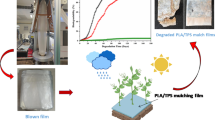Abstract
A Rhizopus stolonifer culture has been used in solid-state fermentation process on tomato pomace using potato dextrose agar as a support. The objective of this research is to use a process factors such as inoculum concentration and fermentation time for optimizing the process responses such as protein content, fat content, lycopene content, and total phenolic content (TPC) using central composite design-response surface methodology technique (CCD-RSM). The favorable conditions for two process factors, i.e., inoculum concentration and fermentation time, were analyzed using CCD. The optimum outcomes were 10.51 fermentation time and 1.22% inoculum concentration exhibited maximum protein content (24.67%), fat content (19.61%), lycopene content (2.61 mg/100 g), and TPC (8.29 mg GAE/g), respectively. Analysis of variance (ANOVA) method predicted the same dependency of process responses on process factors.





Similar content being viewed by others
References
F. Abidi, F. Limam, M.M. Nejib, Production of alkaline proteases by Botrytis cinerea using economic raw materials: assay as biodetergent. Process Biochem. 43, 1202–1208 (2008)
S. Agarwal, A.V. Rao, Tomato lycopene and low density lipoprotein oxidation: a human dietary intervention study. Lipids 33, 981–984 (1998)
A. Akindahunsi, G. Oboh, A. Oshodi, Effect of fermenting cassava with Rhizopus oryzae on the chemical composition of its flour and gari products. Riv. Ital. Sostanze Grasse 76, 437–440 (1999)
F. Akindumila, B.A. Glatz, Growth and oil production of Apiotrichum curvatum in tomato juice. J. Food Prot. 61, 1515–1517 (1998)
H. Ala’a, M. Al-Harahsheh, M. Hararah, T. Magee, Drying characteristics and quality change of unutilized-protein rich-tomato pomace with and without osmotic pre-treatment. Ind. Crops Prod. 31, 171–177 (2010)
C. Li, L. Ma, L. Wang, Z. Zhang, Y. Chen, J. Chen et al., Optimization of solid-state fermentation conditions of Quercus liaotungensis by Bacillus subtilis. Fermentation 9, 75 (2023)
F. Zhao, M. Zheng, X. Xu, Microbial conversion of agro-processing waste (peanut meal) to rhamnolipid by Pseudomonas aeruginosa: solid-state fermentation, water extraction, medium optimization and potential applications. Bioresour. Technol. 369, 128426 (2023)
S. Saeed, T. Mehmood, M. Irfan, Statistical optimization of cultural parameters for the optimized production of alginic acid using apple (Malus domestica) peels through solid-state fermentation. Biomass Convers. Biorefin. 13, 1269–1277 (2023)
H. Mazhar, I. Ullah, U. Ali, N. Abbas, Z. Hussain, S.S. Ali et al., Optimization of low-cost solid-state fermentation media for the production of thermostable lipases using agro-industrial residues as substrate in culture of Bacillus amyloliquefaciens. Biocatal. Agric. Biotechnol. 47, 102559 (2023)
S. Azabou, Y. Abid, H. Sebii, I. Felfoul, A. Gargouri, H. Attia, Potential of the solid-state fermentation of tomato by products by Fusarium solani pisi for enzymatic extraction of lycopene. LWT Food Sci. Technol. 68, 280–287 (2016)
P. Jamal, A. Hashlamona, I. Jaswir, I. Akbar, W. Nawawi, Extraction of lycopene from tomato waste using solid state fermentation. Int. Food Res. J. 24, 482 (2017)
J.Y. Mendez-Carmona, K.N. Ramírez-Guzman, J.A. Ascacio-Valdes, L. Sepulveda, C.N. Aguilar, Solid-state fermentation for recovery of carotenoids from tomato waste. Innov. Food Sci. Emerg. Technol. 80, 103108 (2022)
L.O. Cano y Postigo, D.A. Jacobo-Velázquez, D. Guajardo-Flores, L.E. Garcia Amezquita, T. García-Cayuela, Solid-state fermentation for enhancing the nutraceutical content of agrifood by-products: Recent advances and its industrial feasibility. Food Biosci. 41, 100926 (2021)
F. Carvalheiro, J.C. Roseiro, M.A. Collaco, Biological conversion of tomato pomace by pure and mixed fungal cultures. Process Biochem. 29, 601–605 (1994)
G. Hanrahan, K. Lu, Application of factorial and response surface methodology in modern experimental design and optimization. Crit. Rev. Anal. Chem. 36, 141–151 (2006)
P. Jaiswal, S.N. Jha, K. Narsaiah, R. Bhardwaj, Rapid prediction of microbial load on intact mango surface using spectroscopy. J. Agric. Eng. 51, 19–28 (2014)
S.N. Jha, R. Sharma, Physical, gravimetric and functional characterization of various milling fractions of popped gorgon nut (Euryale ferox). J. Food Sci. Technol. 47, 564–570 (2010)
S. Jha, R. Sharma, Modelling of milk absorption characteristics of popped gorgon nut (Euryale ferox). J. Agric. Eng. 47, 36–39 (2010)
A. Jabeen, H. Naik, N. Jan, S.Z. Hussain, T. Amin, A. Rafiq, Studying the effect of tomato pomace incorporation on physicochemical, nutritional and storage characteristics of corn-based extrudates using response surface approach. Br. Food J. 124, 3705–3723 (2022)
P.S.N. Chada, P.H. Santos, L.G.G. Rodrigues, G.A.S. Goulart, J.D.A. Dos Santos, M. Maraschin et al., Non-conventional techniques for the extraction of antioxidant compounds and lycopene from industrial tomato pomace (Solanum lycopersicum L.) using spouted bed drying as a pre-treatment. Food Chem. X 13, 100237 (2022)
T. Ouatmani, H. Haddadi-Guemghar, L. Boulekbache-Makhlouf, D. Mehidi-Terki, A. Maouche, K. Madani, A sustainable valorization of industrial tomato seeds (cv Rio Grande): Sequential recovery of a valuable oil and optimized extraction of antioxidants by microwaves. J. Food Process. Preserv. 46, e16123 (2022)
Ö.K. Esmer, E. Koçak, A.E. Cevrem, O. Kıcıkoğlu, Alkali extraction of phenolic compounds from tomato peel: optimization of extraction conditions and investigation of phenolic profile by LC-MS/MS. Turk. J. Agric. Food Sci. Technol. 10, 2966–2976 (2022)
Funding
There is no funding used to write this manuscript.
Author information
Authors and Affiliations
Corresponding author
Ethics declarations
Conflict of interest
There is no conflict of interest among the authors of this paper.
Additional information
Publisher's Note
Springer Nature remains neutral with regard to jurisdictional claims in published maps and institutional affiliations.
Supplementary Information
Below is the link to the electronic supplementary material.
Rights and permissions
Springer Nature or its licensor (e.g. a society or other partner) holds exclusive rights to this article under a publishing agreement with the author(s) or other rightsholder(s); author self-archiving of the accepted manuscript version of this article is solely governed by the terms of such publishing agreement and applicable law.
About this article
Cite this article
Singh, J., Dwivedi, B. & Kumar, V. Optimization of Solid-State Fermentation Conditions for Enhancing the Nutrition Contents in Tomato Pomace Using RSM. J. Inst. Eng. India Ser. A (2024). https://doi.org/10.1007/s40030-024-00783-8
Received:
Accepted:
Published:
DOI: https://doi.org/10.1007/s40030-024-00783-8




